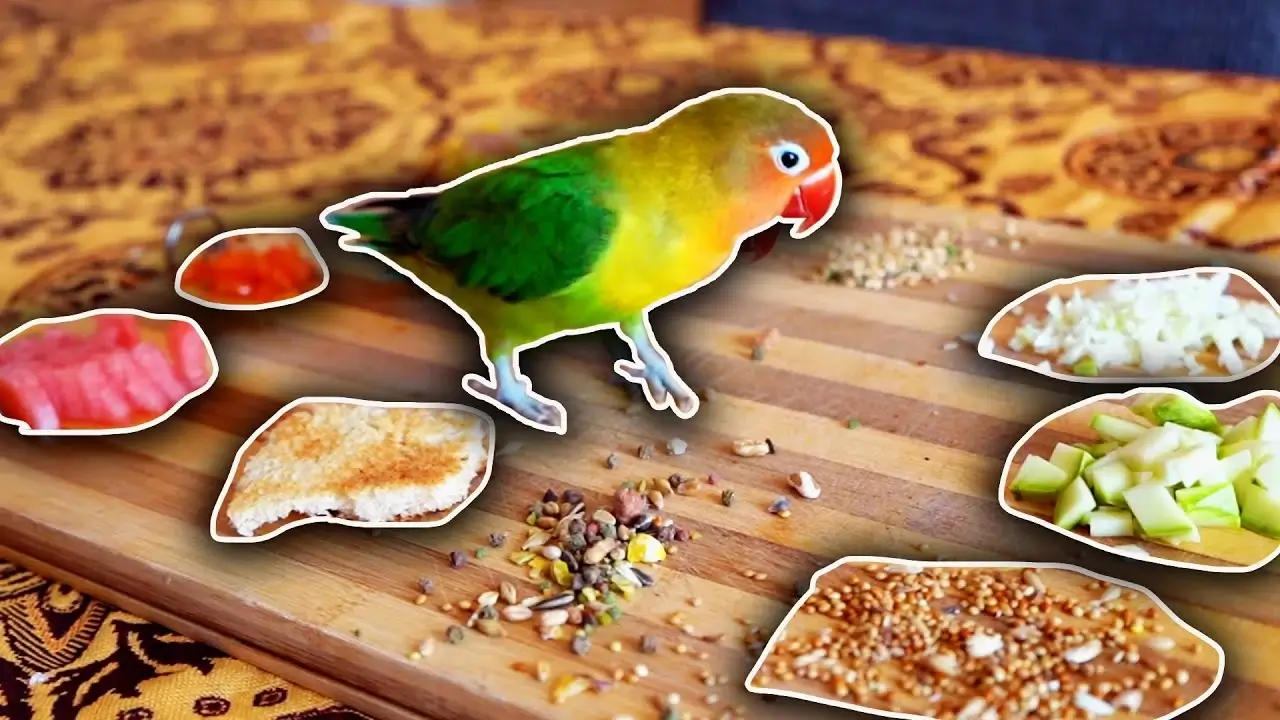What do lovebirds like to eat? Explore ideal diets with seeds, fruits, and more to keep your feathered friends happy and healthy.
Introduction
Welcome to this comprehensive guide on understanding Lovebirds’ dietary preferences and the significance of proper nutrition for these charming avian companions. In this introduction, we’ll set the stage for the journey ahead, giving you a sneak peek into what you can expect from this guide.
Understanding Lovebirds’ Dietary Preferences
Lovebirds, known for their vibrant plumage and affectionate nature, are delightful companions for bird enthusiasts. To ensure their well-being and happiness, it’s essential to understand their dietary preferences. This chapter will delve into the unique food choices that Lovebirds favor and why catering to their culinary inclinations is vital.
What Do Lovebirds Like to Eat?
Proper nutrition forms the foundation of a Lovebird’s health and longevity. In this section, we’ll explore why providing a well-balanced diet is crucial to their overall well-being. From physical health to emotional contentment, nutrition plays a pivotal role in the lives of these avian pets.
What to Expect in This Comprehensive Guide
Before we embark on this journey through Lovebirds’ dietary needs, let’s take a moment to outline what you can expect from this comprehensive guide. Each chapter is meticulously designed to provide valuable insights into Lovebirds’ dietary requirements and how you can cater to them effectively. So, get ready to discover the world of Lovebirds’ nutrition in detail.
Lovebirds’ Natural Diet
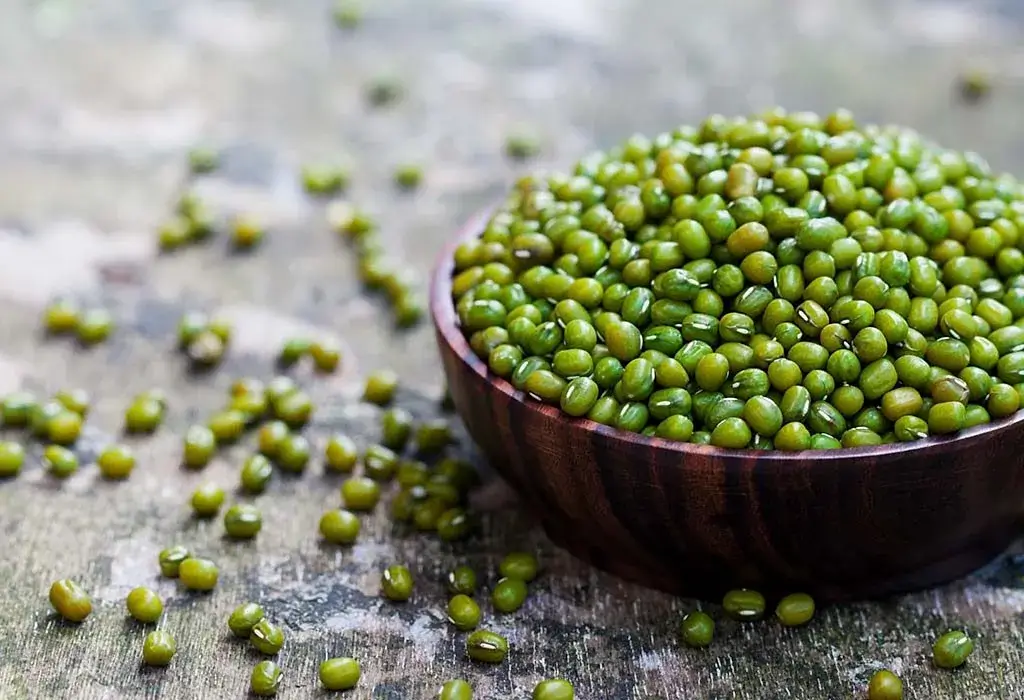
When it comes to understanding what Lovebirds like to eat, a crucial starting point is examining their natural diet in the wild. In this chapter, we will embark on a journey through the native habitats of these charming birds, exploring their preferences and seasonal adaptations.
Lovebirds in the Wild: Exploring Their Habitat and Behavior
Lovebirds are indigenous to the African continent, primarily dwelling in arid regions. They are often spotted in savannas, woodlands, and near water sources. Understanding their natural habitat provides valuable insights into their dietary choices. These lively creatures enjoy a diverse and vibrant environment, which directly influences what they consume.
In the wild, Lovebirds are known to feed on a wide range of food sources, including various types of seeds, fruits, berries, and vegetation. Their adaptability to different food supplies in the wild showcases their flexibility when it comes to diet.
Seeds: The Core of Lovebirds’ Diet
Seeds are the cornerstone of Lovebirds’ diets. In the wild, they readily forage for different seeds, ranging from grass seeds to various plant seeds. This preference for seeds not only fuels their energy but also provides essential nutrients. Understanding the types of seeds they consume is fundamental to replicating their natural diet in captivity.
Omnivores at Heart: Unveiling Lovebirds’ Versatile Food Choices
While seeds are their primary food source, Lovebirds are true omnivores at heart. They are not exclusive seed-eaters but also relish other food items, including fruits, vegetables, and even the occasional insect. This dietary flexibility allows them to adapt to varying food availability throughout the year.
Seasonal Adaptations: How Lovebirds Modify Their Diet
To survive in their natural habitat, Lovebirds exhibit seasonal dietary adaptations. During times of plenty, they may consume a greater variety of fruits and vegetation. In contrast, during dry periods, seeds become the primary focus of their diet. These adjustments emphasize their ability to adapt to changing environmental conditions, making them resilient birds.
FAQ: What Do Lovebirds Consume in Their Natural Environment?
What are Lovebirds’ favorite seeds in the wild?
Do Lovebirds eat insects in the wild?
How do Lovebirds adapt their diet to different seasons?
This chapter sets the stage by offering a deep dive into Lovebirds’ natural dietary habits, shedding light on their wild preferences and behavior. Understanding their innate inclinations will prove invaluable when it comes to nurturing these lovely birds in your care.
Popular Seed Choices for Lovebirds
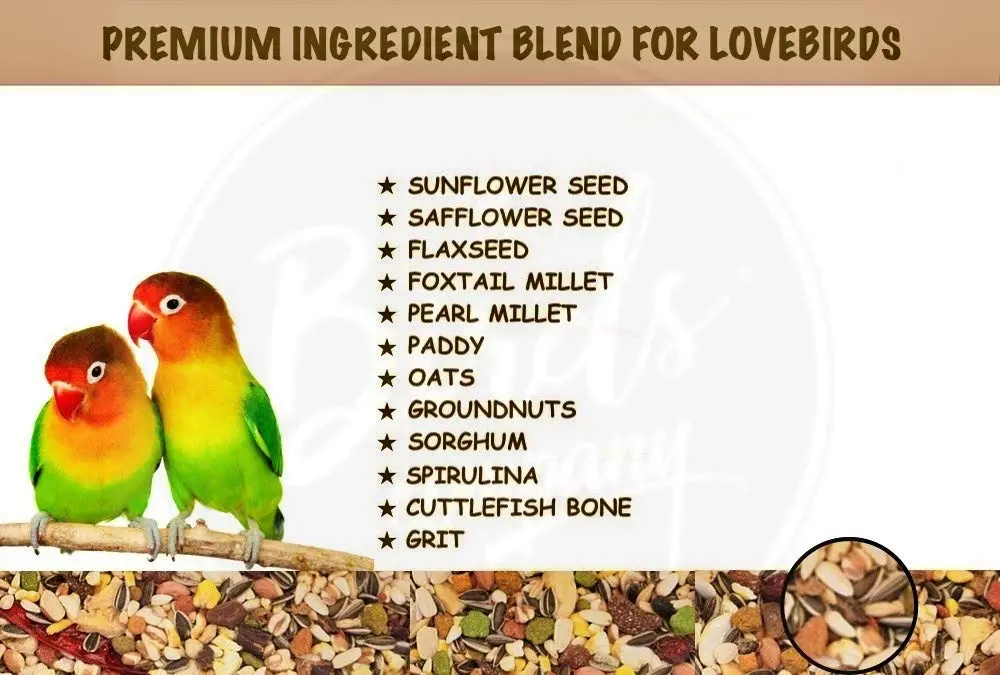
Lovebirds are known for their diverse and sometimes quirky dietary preferences. Seeds make up a significant part of their natural diet, providing essential nutrients and energy. In this chapter, we’ll explore some of the most popular seed choices for Lovebirds and how they contribute to a balanced diet.
Millet Seeds: Lovebirds’ Beloved Staple
Millet seeds hold a special place in Lovebirds’ hearts. These tiny, round seeds are a staple in their diet, cherished for their delicious taste and nutritional value. Millets provide carbohydrates, protein, and fiber, making them an excellent source of energy for these active birds.
Sunflower Seeds: A Nutrient-Rich Option
Sunflower seeds are another favorite among Lovebirds. They are packed with essential nutrients, including healthy fats, vitamins, and minerals. However, it’s crucial to offer them in moderation due to their high-fat content.
Canary Grass Seeds: Small but Nutritious
Canary grass seeds are small, but they pack a nutritious punch. Lovebirds enjoy these seeds for their mild, nutty flavor. They provide a variety of nutrients and add diversity to the birds’ diet.
Safflower Seeds: A Treat for Lovebirds
Safflower seeds are a tasty treat for Lovebirds. They are rich in healthy fats and fiber, promoting heart health and aiding digestion. However, like sunflower seeds, safflower seeds should be offered in limited quantities.
The Art of Mixing Seeds for a Balanced Diet
While Lovebirds have their seed preferences, it’s essential to mix various seeds to ensure a balanced diet. A combination of millet, sunflower, canary grass, and safflower seeds can provide a broader spectrum of nutrients and prevent dietary imbalances.
By offering a well-balanced mix of seeds, you can mimic the variety they would encounter in the wild. Just remember to monitor their seed intake and complement their diet with other essential food groups, which we’ll explore in later chapters.
As you delve into the world of Lovebirds’ seed choices, keep in mind that moderation and variety are key to a nutritious and enjoyable diet for your feathered friends. In the following chapters, we’ll uncover the role of fruits, vegetables, and supplementary foods in Lovebirds’ nutrition.
Introducing Fruits into Lovebirds’ Diet
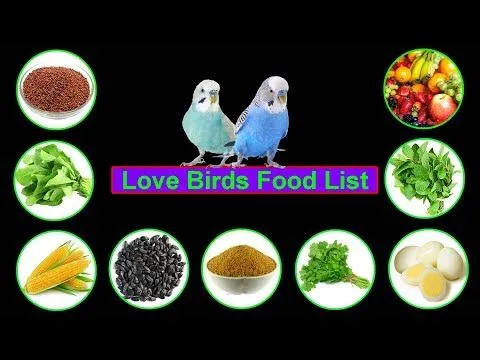
Fruits are a delightful addition to Lovebirds’ diets, providing a burst of flavor, vitamins, and natural sugars. In this chapter, we’ll dive into the role of fruits in Lovebirds’ nutrition and explore their favorite fruit selections.
The Role of Fruits in Lovebirds’ Nutrition
Fruits play a vital role in Lovebirds’ diets, contributing essential nutrients that help support their overall health. Here’s what makes fruits a valuable part of their diet:
- Vitamins and Minerals: Fruits are rich in a variety of vitamins, including vitamin C, which is crucial for Lovebirds’ immune systems. They also contain essential minerals like potassium and magnesium.
- Antioxidants: Many fruits are packed with antioxidants, which help combat free radicals and reduce the risk of diseases.
- Natural Sugars: Fruits provide natural sugars that offer a quick source of energy, which is especially beneficial for active Lovebirds.
Lovebirds’ Favorite Fruits: A Colorful Selection
Lovebirds have their preferences when it comes to fruits. These colorful selections are likely to bring joy to your feathered friends:
- Apples: Lovebirds adore apples, which are not only delicious but also packed with vitamins and dietary fiber.
- Berries: Blueberries and strawberries are a hit among Lovebirds. They are nutrient-rich and make for a tasty treat.
- Citrus Fruits: Oranges, lemons, and other citrus fruits provide a dose of vitamin C. Lovebirds may enjoy nibbling on citrus slices.
- Bananas: Bananas are a Lovebird favorite due to their creamy texture and natural sweetness. They are an excellent source of energy.
- Grapes: Grapes are easy for Lovebirds to handle and a good source of hydration and vitamins.
Portion Control: How Much Fruit to Offer
While fruits are a valuable part of Lovebirds’ diet, it’s essential to practice moderation. Too much fruit can lead to excess sugar intake and potential weight issues. Here are some tips for offering fruits:
- Small Portions: Start with small portions to gauge your Lovebird’s preference. You can gradually increase the quantity.
- Variety: Offer a variety of fruits to ensure they receive a wide range of nutrients. A colorful mix is not only healthy but visually stimulating.
- Remove Seeds: Always remove any seeds from fruits like apples, as they can be harmful to Lovebirds.
Fruits should complement the main diet, which includes seeds and, later, vegetables. By providing a balanced and varied diet, you can ensure that your Lovebirds enjoy a healthy and delicious meal plan. In the next chapter, we’ll explore the world of vegetables and how they benefit your avian companions.
The World of Vegetables in Lovebirds’ Diet
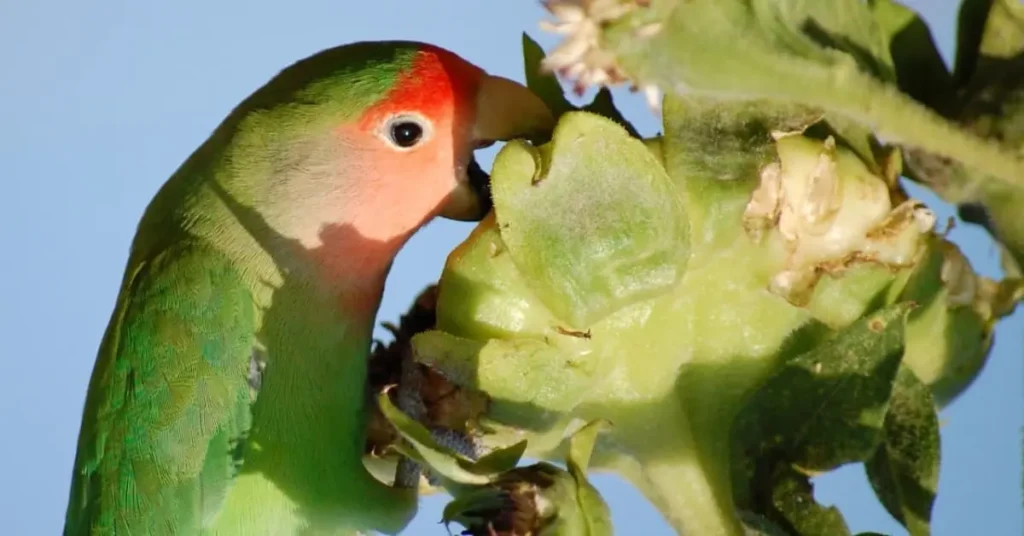
Vegetables are an essential component of a balanced Lovebird diet. In this chapter, we’ll explore the nutritional value of vegetables for Lovebirds and recommend some safe and nutritious choices.
The Nutritional Value of Vegetables for Lovebirds
Vegetables offer a wide range of nutrients that are beneficial for Lovebirds:
- Vitamins: Vegetables contain essential vitamins such as vitamin A, vitamin C, and vitamin K. These vitamins support Lovebirds’ growth and overall health.
- Minerals: Minerals like calcium, phosphorus, and magnesium are crucial for Lovebirds’ bone health and proper body functions.
- Dietary Fiber: Vegetables are a great source of dietary fiber, aiding in digestion and preventing obesity.
- Hydration: Certain vegetables, like cucumbers, have a high water content, helping to keep Lovebirds hydrated.
Recommended Vegetables for Lovebirds
Not all vegetables are suitable for Lovebirds. Here are some that they tend to enjoy and benefit from:
- Carrots: Rich in beta-carotene, carrots support Lovebirds’ eye health and provide a satisfying crunch.
- Bell Peppers: Lovebirds appreciate the vibrant colors of bell peppers. They are high in vitamin C and antioxidants.
- Broccoli: A source of vitamin K and calcium, broccoli helps with bone health.
- Zucchini: Zucchini is hydrating and offers essential vitamins and minerals.
- Kale: A leafy green that provides a variety of nutrients, including iron and vitamin A.
Exploring Safe and Unsafe Choices
While offering vegetables, it’s essential to be aware of safe and unsafe choices:
Safe Vegetables:
- Wash and chop vegetables into manageable sizes for your Lovebirds.
- Remove any seeds or pits, as they can be harmful.
- Start with small portions and introduce new vegetables gradually.
Unsafe Vegetables:
- Avoid vegetables from the nightshade family, such as tomatoes, as they can be toxic to Lovebirds.
- Onions and garlic should also be avoided, as they can cause digestive issues.
By incorporating vegetables into your Lovebirds’ diet, you provide them with essential nutrients and a diverse menu to enjoy. Next, we’ll delve into supplementary foods that can add variety and nutrition to their meals.
Supplementary Foods for Lovebirds
Supplementary foods play a crucial role in providing a well-rounded diet for Lovebirds. In this chapter, we will explore the importance of nutritional variety and how to enhance your Lovebird’s diet with fresh vegetables and homemade treats.
Nutritional Variety: The Key to a Happy Lovebird
Offering a diverse range of foods ensures that your Lovebirds receive all the essential nutrients. This variety can contribute to their overall happiness and well-being. To achieve this, consider the following:
- Different Textures: Mix foods with varying textures, from crunchy seeds to soft fruits and vegetables. Lovebirds enjoy the sensory experience.
- Colors and Flavors: Vary the colors and flavors of the foods you offer. This stimulates their curiosity and appetite.
- Nutrient-Rich Selection: Ensure that the foods you choose are rich in essential vitamins, minerals, and antioxidants.
Fresh Vegetables in Lovebirds’ Diet
Fresh vegetables are a fantastic addition to your Lovebird’s diet. They provide essential nutrients and hydration. Some Lovebird-friendly vegetables include:
- Leafy Greens: Offer leafy greens like kale, spinach, and Swiss chard. These are rich in vitamins and minerals.
- Cucumbers: Cucumbers have a high water content, making them a great hydrating snack.
- Bell Peppers: Colorful bell peppers are packed with vitamin C and antioxidants.
- Zucchini: Zucchini is another hydrating and nutrient-rich option.
Introduce fresh vegetables gradually, starting with small portions to ensure that your Lovebirds adapt to them.
Homemade Lovebird Food: Preparing Nutrient-Rich Treats
Creating homemade Lovebird treats allows you to control the ingredients and ensure they are healthy. Here are a few ideas for homemade Lovebird treats:
- Lovebird Muffins: Prepare muffins with Lovebird-friendly ingredients, such as whole grains and fresh fruits.
- Baked Oatmeal Bars: Bake oatmeal bars with nuts, seeds, and dried fruits. These provide a nutritious snack.
- Smoothies: Blend fresh fruits and vegetables into smoothies. Lovebirds often enjoy the taste and texture.
When making homemade treats, avoid adding sugar, salt, or any harmful additives. Always consult with an avian veterinarian or a bird nutritionist for guidance on preparing the best homemade treats for your Lovebirds.
FAQ: Can Lovebirds Eat Bananas?
Bananas are a popular fruit; you might wonder if your Lovebirds can enjoy them. The answer is yes! Lovebirds can eat bananas in moderation. They are a good source of vitamins and potassium. Ensure the banana pieces are ripe and cut them into small, manageable sizes.
In the next chapter, we will delve into the foods that Lovebirds should avoid to maintain their health and safety.
Foods Lovebirds Should Avoid
Ensuring the safety and well-being of your beloved Lovebirds is paramount. In this chapter, we’ll discuss the foods that Lovebirds should avoid at all costs and how to recognize and prevent potential dangers.
A Red Flag Diet: Foods to Keep Away From
Not all foods are safe for Lovebirds, and some should never be a part of their diet. Avoid feeding the following:
- Chocolate: Chocolate contains theobromine, which is toxic to birds.
- Caffeine: Like chocolate, caffeine is harmful to Lovebirds. Keep them away from coffee, tea, and energy drinks.
- Alcohol: Alcohol can quickly lead to alcohol poisoning in Lovebirds.
- Processed and Sugary Foods: Highly processed and sugary items like candies and sweets have no nutritional value and can lead to health problems.
- Avocado: Avocado contains a toxin called persin, which is dangerous for Lovebirds.
Toxic Foods for Lovebirds: Recognizing and Preventing Danger
Some seemingly harmless foods can be toxic to Lovebirds, and it’s essential to recognize and prevent potential hazards:
- Onions and Garlic: These can cause digestive issues and should be avoided.
- High-Sodium Foods: Excessive salt intake can harm your Lovebirds. Avoid salty snacks and processed foods.
- High-Fat Foods: Foods high in fat, like fried items, can lead to obesity and other health problems.
- Fruit Seeds: While fruits are generally safe, be cautious with fruit seeds, as they may contain toxins.
Ensuring Safety: Creating a Hazard-Free Dining Environment
Apart from selecting the right foods, it’s crucial to provide a safe dining environment for your Lovebirds. Here are some tips:
- Clean Food and Water Dishes: Regularly clean and disinfect your Lovebirds’ food and water dishes to prevent contamination.
- No Smoking: Keep your Lovebirds away from areas where people smoke, as secondhand smoke can be harmful.
- Proper Storage: Store bird food in airtight containers to prevent contamination by pests or mold.
- Safe Foraging: If you let your Lovebirds forage for food, ensure they only find safe and approved items.
FAQ: What Home Foods Are Harmful to Lovebirds?
Q: What common home foods should I absolutely avoid giving to my Lovebirds?
A: Lovebirds should never consume chocolate, caffeine, alcohol, processed and sugary foods, and avocado. Additionally, be cautious with onions, garlic, high-sodium foods, high-fat foods, and fruit seeds.
By being diligent in understanding and avoiding harmful foods, you can help ensure the health and happiness of your Lovebirds. In the next chapter, we will explore how to craft a balanced diet plan that takes into account your Lovebirds’ unique needs.
Crafting a Balanced Diet Plan
Providing your Lovebirds with a well-balanced diet is crucial for their health and happiness. In this chapter, we’ll delve into the intricacies of crafting a diet plan tailored to your feathered companions.
Scheduling Lovebirds’ Meals: Creating a Feeding Routine
Establishing a regular feeding routine is essential for Lovebirds. Here’s how to schedule their meals effectively:
- Consistency: Feed your Lovebirds at the same times each day to establish a predictable routine.
- Fresh Water: Ensure fresh, clean water is available at all times.
- Monitor Consumption: Keep an eye on how much your Lovebirds eat to adjust portion sizes as needed.
Finding the Right Proportions: Balancing Seeds, Fruits, and Vegetables
Balancing the different food groups in your Lovebirds’ diet is key. Consider the following:
- Seeds: They should make up around 60-70% of your Lovebirds’ diet.
- Fruits: Allocate about 20-30% for fruits, providing essential vitamins and minerals.
- Vegetables: The remaining 10-20% should consist of fresh, bird-safe vegetables.
Tailoring the Diet for Pet Lovebirds: Addressing Unique Needs
Each Lovebird may have its dietary preferences and requirements. Customize your diet plan by considering:
- Activity Level: Active Lovebirds may require more calories, while sedentary ones should have a more controlled diet.
- Health Conditions: Lovebirds with health issues may need specialized diets. Consult your avian vet for guidance.
- Individual Tastes: Observe your Lovebirds’ favorite foods and incorporate them into their diet.
FAQ: How to Create a Diet Schedule for Lovebirds?
Q: What’s the best way to create a diet schedule for my Lovebirds?
A: Start with a consistent feeding routine and adjust the proportions of seeds, fruits, and vegetables based on your Lovebirds’ preferences and needs. Monitor their consumption and consult with an avian vet if you have concerns about their diet.
By following these guidelines, you can ensure that your Lovebirds receive the proper nutrition they need. In the next chapter, we will explore special considerations for Lovebirds, including dietary essentials for breeding pairs.
Special Considerations for Lovebirds
Lovebirds are fascinating and diverse creatures, and their dietary needs can vary based on their life stages and unique circumstances. In this chapter, we will explore the special considerations for Lovebirds, from breeding pairs to addressing health and nutritional concerns.
Breeding Lovebirds: Dietary Essentials for Productive Pairs
Breeding Lovebirds have specific dietary requirements to support their reproductive processes and the healthy development of their chicks:
- Increased Calories: Breeding Lovebirds need more calories to support egg-laying and chick-rearing. Provide additional seeds and high-calorie foods.
- Calcium and Protein: Offer calcium-rich foods such as cuttlebone and a variety of protein sources like egg food to meet their increased nutritional demands.
- Supplements: Some breeders use specialized supplements to ensure that breeding pairs receive all the necessary nutrients. Consult with an avian vet for recommendations.
Lovebirds’ Age and Diet: Meeting the Needs of Different Life Stages
Lovebirds go through various life stages, each with its dietary requirements:
- Hatchlings: Baby Lovebirds rely on regurgitated food from their parents initially, followed by a diet of soft, easily digestible foods.
- Juveniles: As Lovebirds grow, their diet transitions to a mix of seeds, soft foods, and fresh fruits and vegetables.
- Adults: Mature Lovebirds require a balanced diet, with seeds forming the core and supplemented with fresh produce.
- Seniors: Older Lovebirds may need modifications to their diet based on their health and activity level.
Addressing Dietary Issues: Health and Nutritional Concerns
Like any pet, Lovebirds can face dietary challenges and health issues. Here’s how to address them:
- Obesity: If your Lovebird is overweight, consult with an avian vet to create a weight management plan.
- Vitamin Deficiencies: Ensure your Lovebirds receive a variety of foods to avoid nutritional deficiencies.
- Allergies: Pay attention to any allergic reactions to specific foods and eliminate them from their diet.
- Special Health Needs: Lovebirds with health conditions may require specialized diets. Consult with an avian vet for guidance.
FAQ: What Should You Feed African Lovebirds?
Q: Are there specific dietary considerations for African Lovebirds?
A: African Lovebirds have similar dietary requirements as other Lovebird species. However, always consider individual needs, life stages, and health conditions when planning their diet.
Understanding the unique dietary requirements for breeding Lovebirds, and different life stages, and addressing health and nutritional concerns will help you provide the best possible nutrition for your beloved feathered friends. In the final chapter, we’ll recap Lovebirds’ dietary needs and offer some expert advice for Lovebird owners.
Conclusion
In this comprehensive guide, we’ve delved into the intricate world of Lovebirds and their dietary needs. Understanding what Lovebirds like to eat and how to provide them with a balanced diet is crucial for their well-being and happiness. Let’s recap the key takeaways and provide some final thoughts and expert advice for Lovebird owners.
Recap of Lovebirds’ Dietary Needs
- Seeds: Lovebirds have a strong affinity for seeds, which should form the core of their diet. Millet, sunflower, canary grass, and safflower seeds are popular choices.
- Fruits: A colorful variety of fruits such as apples, grapes, and berries can be included in their diet but in moderation.
- Vegetables: Nutrient-rich vegetables like spinach, carrots, and broccoli are excellent additions to their diet.
- Supplementary Foods: Fresh vegetables, homemade Lovebird food, and occasional treats can provide the necessary nutritional variety.
- Avoid Harmful Foods: Be vigilant about keeping harmful foods away from your Lovebirds, including avocados, chocolate, and caffeine.
The Key to Happy and Healthy Lovebirds
The key to having happy and healthy Lovebirds lies in providing a diet that not only sustains them but also stimulates their natural foraging behavior. A balanced diet ensures their physical and emotional well-being.
Final Thoughts and Expert Advice for Lovebird Owners
As you embark on this journey of caring for Lovebirds, keep the following expert advice in mind:
- Consult an Avian Vet: Regular check-ups with an avian vet can help you assess your Lovebirds’ health and nutritional needs.
- Monitor Their Weight: Regularly weigh your Lovebirds to detect any unusual fluctuations that may indicate health issues.
- Observe Their Preferences: Pay attention to their food preferences and adjust their diet accordingly, keeping it interesting and diverse.
- Safe and Clean Environment: Ensure that their dining environment is safe, clean, and free from toxins.
- Social Interaction: Lovebirds thrive on social interaction, so spend quality time with them to keep them mentally stimulated and emotionally content.
Caring for Lovebirds can be an incredibly rewarding experience. By understanding their dietary needs and offering a diet tailored to their preferences, you’re taking a significant step toward providing them with a happy and healthy life. Enjoy the unique companionship and affection that Lovebirds bring to
